Abstract
Intestinal spirochaetal bacteria were isolated from 59 of 181 (32.6%) faecal samples obtained from Aboriginal children and a few adults living in communities in the Kimberley region in the north of Western Australia. Colonization was more common in young Aborigines between 2 and 18 years of age than it was in adults, or in babies and children less than 2 years of age. Three of 22 Aboriginal children who were sampled on two consecutive years were colonized on both occasions. None of four other children were found to be consistently colonized with the bacteria when sampled on three sequential years, but three were positive on two consecutive visits and the other child was positive on the first and third sampling. Most Aboriginal children had abnormal or watery stools, and both abnormal and watery stool samples were significantly more likely to contain spirochaetes than were normal samples. However, it was not possible to prove that the spirochaetes were the cause of the diarrhoea. In contrast, spirochaetes were only recovered from 8 of 695 (1.2%) faecal samples that were obtained from other mainly non-Aboriginal children and adults in Western Australia or the Northern Territory of Australia, even though most of these individuals were suffering from gastrointestinal disturbances.
Full text
PDF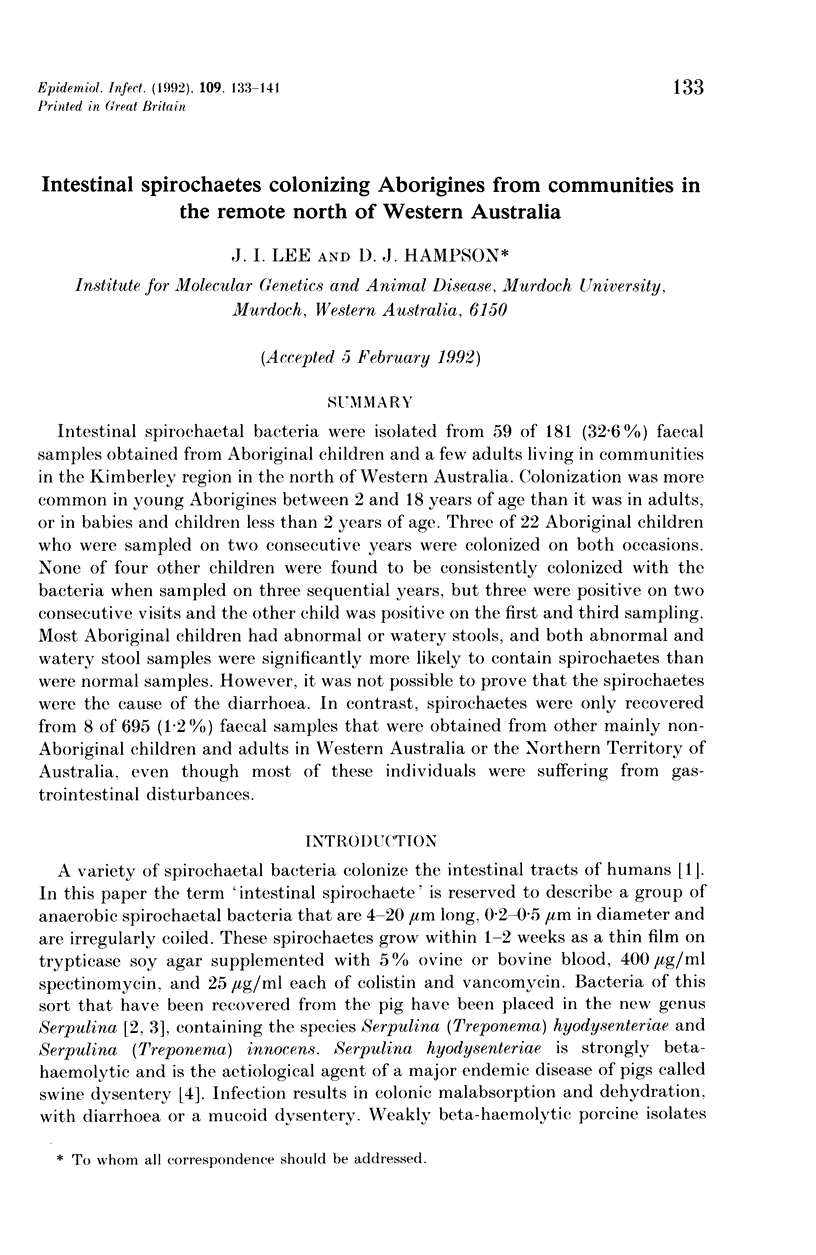

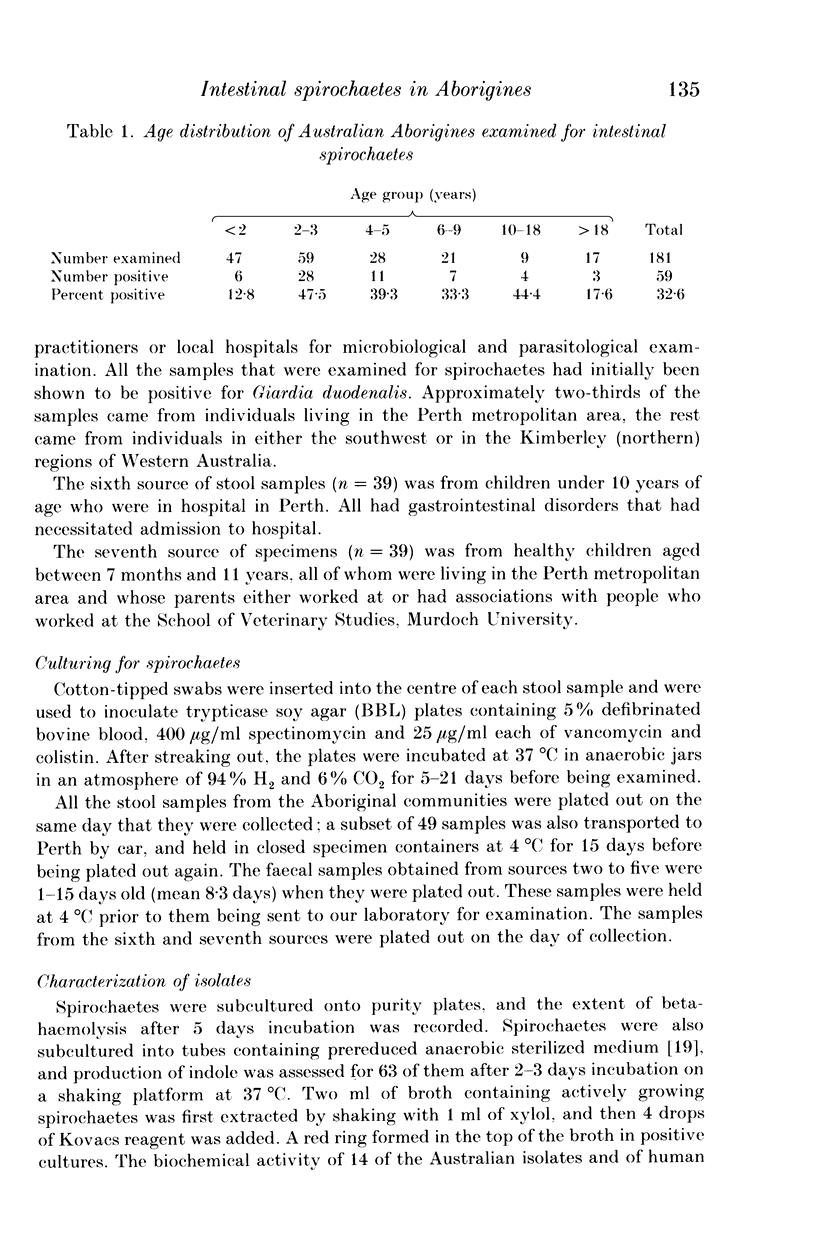
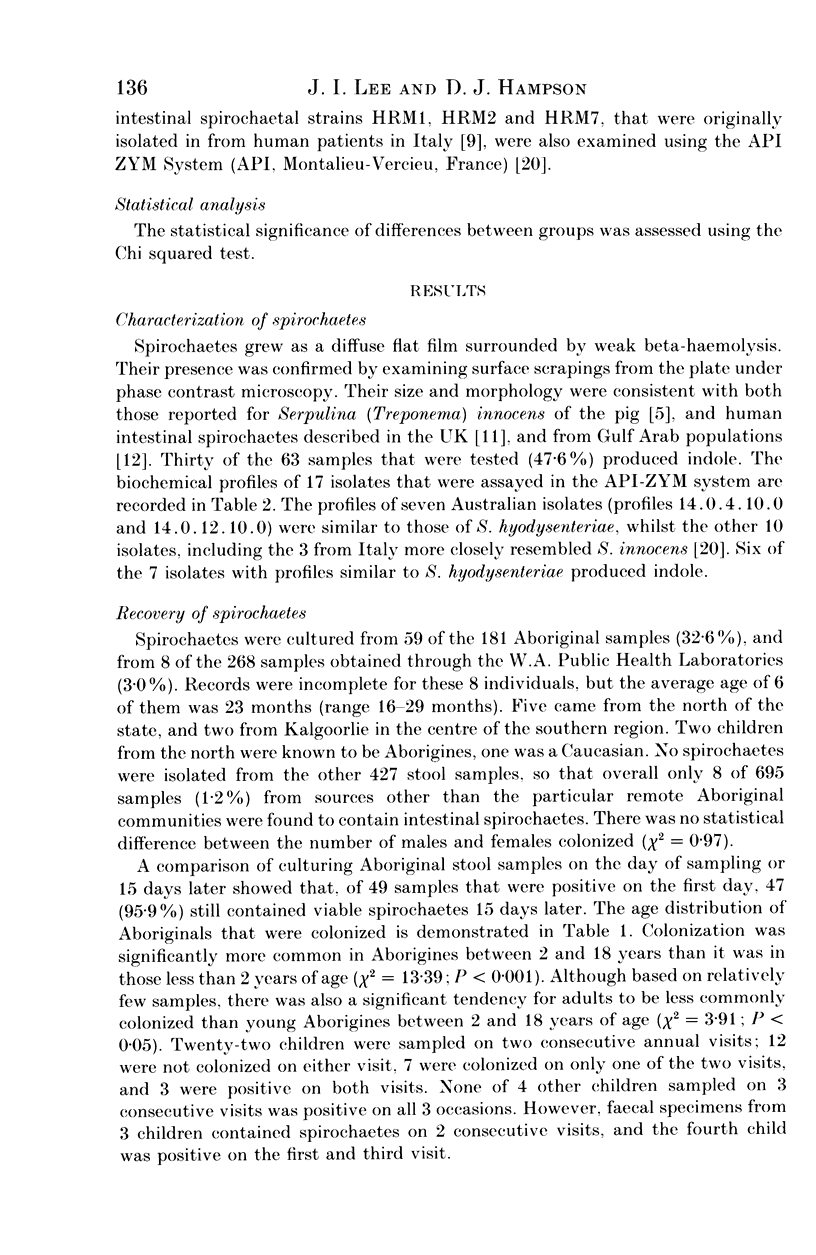

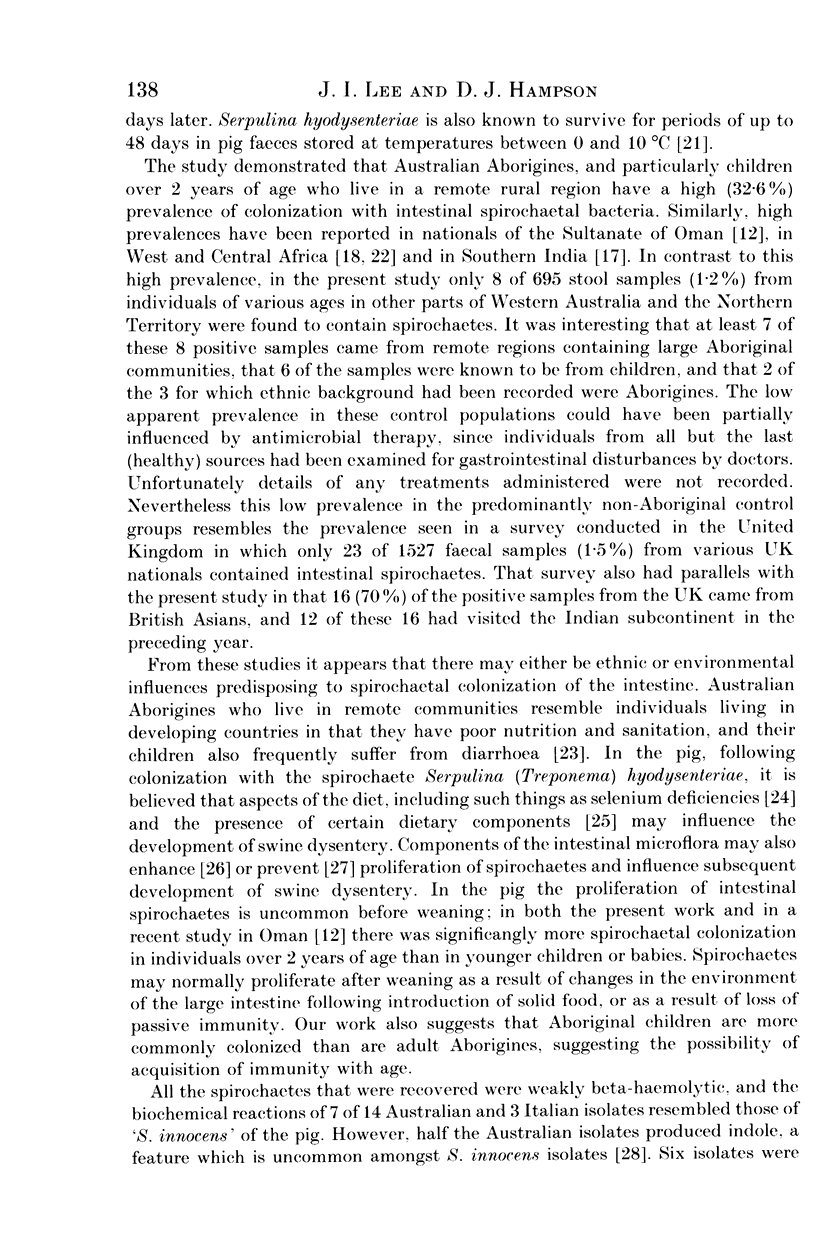

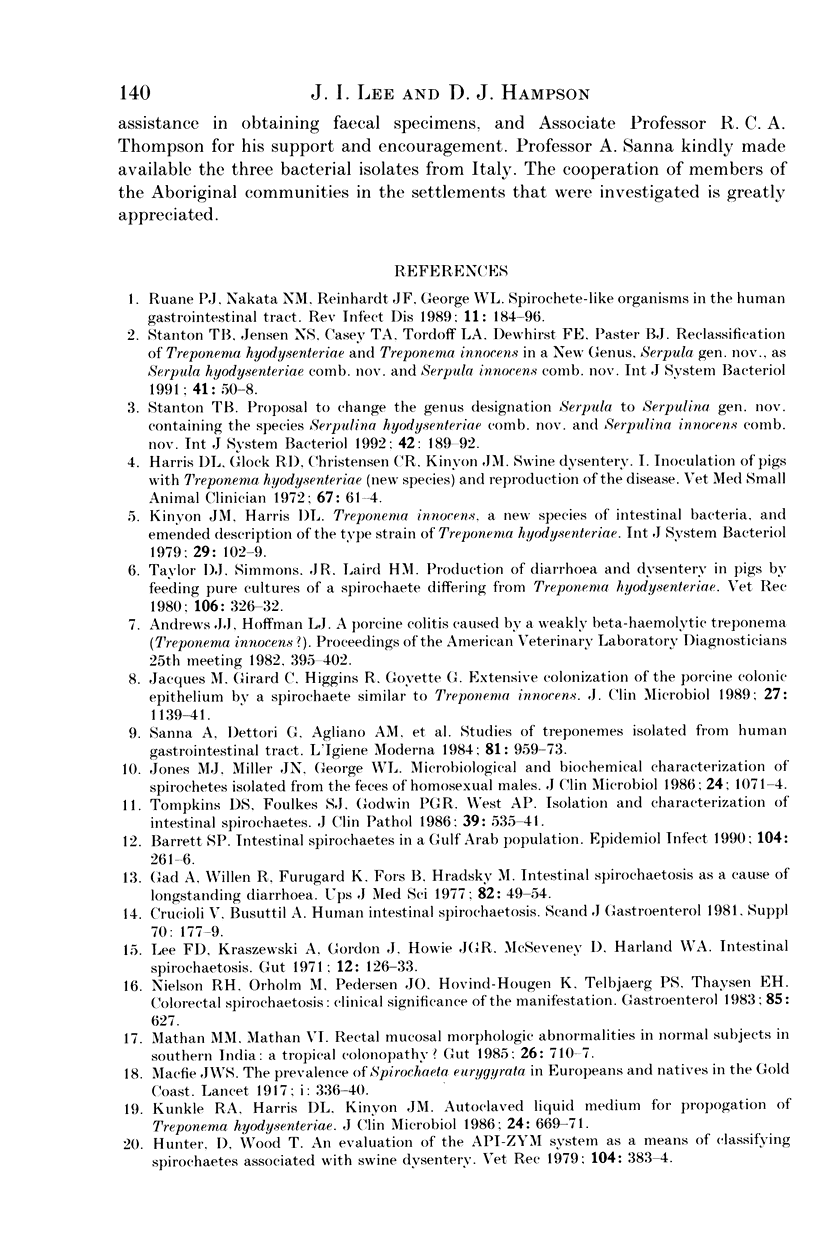
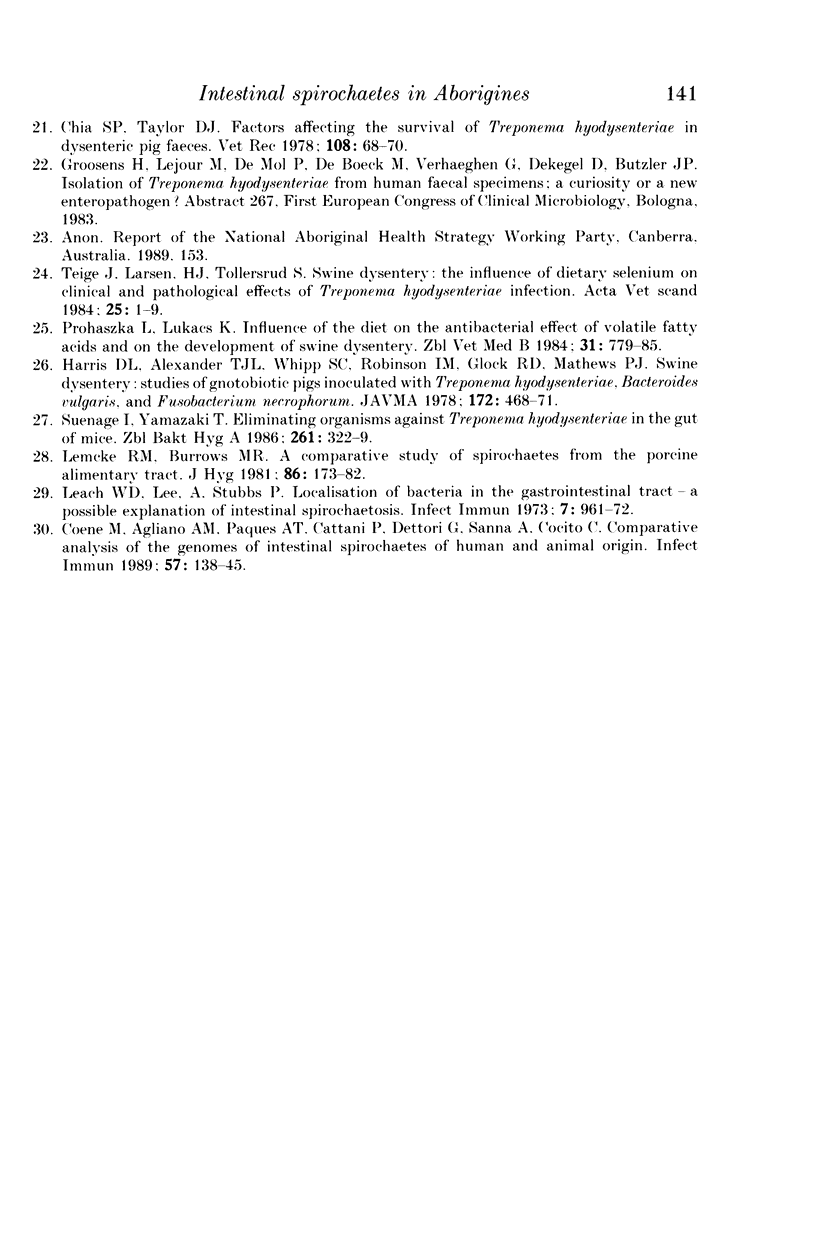
Selected References
These references are in PubMed. This may not be the complete list of references from this article.
- Barrett S. P. Intestinal spirochaetes in a Gulf Arab population. Epidemiol Infect. 1990 Apr;104(2):261–266. doi: 10.1017/s0950268800059434. [DOI] [PMC free article] [PubMed] [Google Scholar]
- Coene M., Agliano A. M., Paques A. T., Cattani P., Dettori G., Sanna A., Cocito C. Comparative analysis of the genomes of intestinal spirochetes of human and animal origin. Infect Immun. 1989 Jan;57(1):138–145. doi: 10.1128/iai.57.1.138-145.1989. [DOI] [PMC free article] [PubMed] [Google Scholar]
- Crucioli V., Busuttil A. Human intestinal spirochaetosis. Scand J Gastroenterol Suppl. 1981;70:177–179. [PubMed] [Google Scholar]
- Harris D. L., Alexander T. J., Whipp S. C., Robinson I. M., Glock R. D., Matthews P. J. Swine dysentery: studies of gnotobiotic pigs inoculated with Treponema hyodysenteriae, Bacteroides vulgatus, and Fusobacterium necrophorum. J Am Vet Med Assoc. 1978 Feb 15;172(4):468–471. [PubMed] [Google Scholar]
- Hunter D., Wood T. An evaluation of the API ZYM system as a means of classifying spirochaetes associated with swine dysentery. Vet Rec. 1979 Apr 28;104(17):383–384. doi: 10.1136/vr.104.17.383. [DOI] [PubMed] [Google Scholar]
- Jacques M., Girard C., Higgins R., Goyette G. Extensive colonization of the porcine colonic epithelium by a spirochete similar to Treponema innocens. J Clin Microbiol. 1989 May;27(5):1139–1141. doi: 10.1128/jcm.27.5.1139-1141.1989. [DOI] [PMC free article] [PubMed] [Google Scholar]
- Jones M. J., Miller J. N., George W. L. Microbiological and biochemical characterization of spirochetes isolated from the feces of homosexual males. J Clin Microbiol. 1986 Dec;24(6):1071–1074. doi: 10.1128/jcm.24.6.1071-1074.1986. [DOI] [PMC free article] [PubMed] [Google Scholar]
- Kunkle R. A., Harris D. L., Kinyon J. M. Autoclaved liquid medium for propagation of Treponema hyodysenteriae. J Clin Microbiol. 1986 Oct;24(4):669–671. doi: 10.1128/jcm.24.4.669-671.1986. [DOI] [PMC free article] [PubMed] [Google Scholar]
- Leach W. D., Lee A., Stubbs R. P. Localization of bacteria in the gastrointestinal tract: a possible explanation of intestinal spirochaetosis. Infect Immun. 1973 Jun;7(6):961–972. doi: 10.1128/iai.7.6.961-972.1973. [DOI] [PMC free article] [PubMed] [Google Scholar]
- Lee F. D., Kraszewski A., Gordon J., Howie J. G., McSeveney D., Harland W. A. Intestinal spirochaetosis. Gut. 1971 Feb;12(2):126–133. doi: 10.1136/gut.12.2.126. [DOI] [PMC free article] [PubMed] [Google Scholar]
- Lemcke R. M., Burrows M. R. A comparative study of spirochaetes from the porcine alimentary tract. J Hyg (Lond) 1981 Apr;86(2):173–182. doi: 10.1017/s0022172400068881. [DOI] [PMC free article] [PubMed] [Google Scholar]
- Mathan M. M., Mathan V. I. Rectal mucosal morphologic abnormalities in normal subjects in southern India: a tropical colonopathy? Gut. 1985 Jul;26(7):710–717. doi: 10.1136/gut.26.7.710. [DOI] [PMC free article] [PubMed] [Google Scholar]
- Prohászka L., Lukács K. Influence of the diet on the antibacterial effect of volatile fatty acids and on the development of swine dysentery. Zentralbl Veterinarmed B. 1984 Dec;31(10):779–785. doi: 10.1111/j.1439-0450.1984.tb01362.x. [DOI] [PubMed] [Google Scholar]
- Ruane P. J., Nakata M. M., Reinhardt J. F., George W. L. Spirochete-like organisms in the human gastrointestinal tract. Rev Infect Dis. 1989 Mar-Apr;11(2):184–196. doi: 10.1093/clinids/11.2.184. [DOI] [PubMed] [Google Scholar]
- Stanton T. B. Proposal to change the genus designation Serpula to Serpulina gen. nov. containing the species Serpulina hyodysenteriae comb. nov. and Serpulina innocens comb. nov. Int J Syst Bacteriol. 1992 Jan;42(1):189–190. doi: 10.1099/00207713-42-1-189. [DOI] [PubMed] [Google Scholar]
- Taylor D. J., Simmons J. R., Laird H. M. Production of diarrhoea and dysentery in pigs by feeding pure cultures of a spirochaete differing from Treponema hyodysenteriae. Vet Rec. 1980 Apr 12;106(15):326–332. doi: 10.1136/vr.106.15.326. [DOI] [PubMed] [Google Scholar]
- Teige J., Jr, Larsen H. J., Tollersrud S. Swine dysentery: the influence of dietary selenium on clinical and pathological effects of Treponema hyodysenteriae infection. Acta Vet Scand. 1984;25(1):1–9. doi: 10.1186/BF03547273. [DOI] [PMC free article] [PubMed] [Google Scholar]


